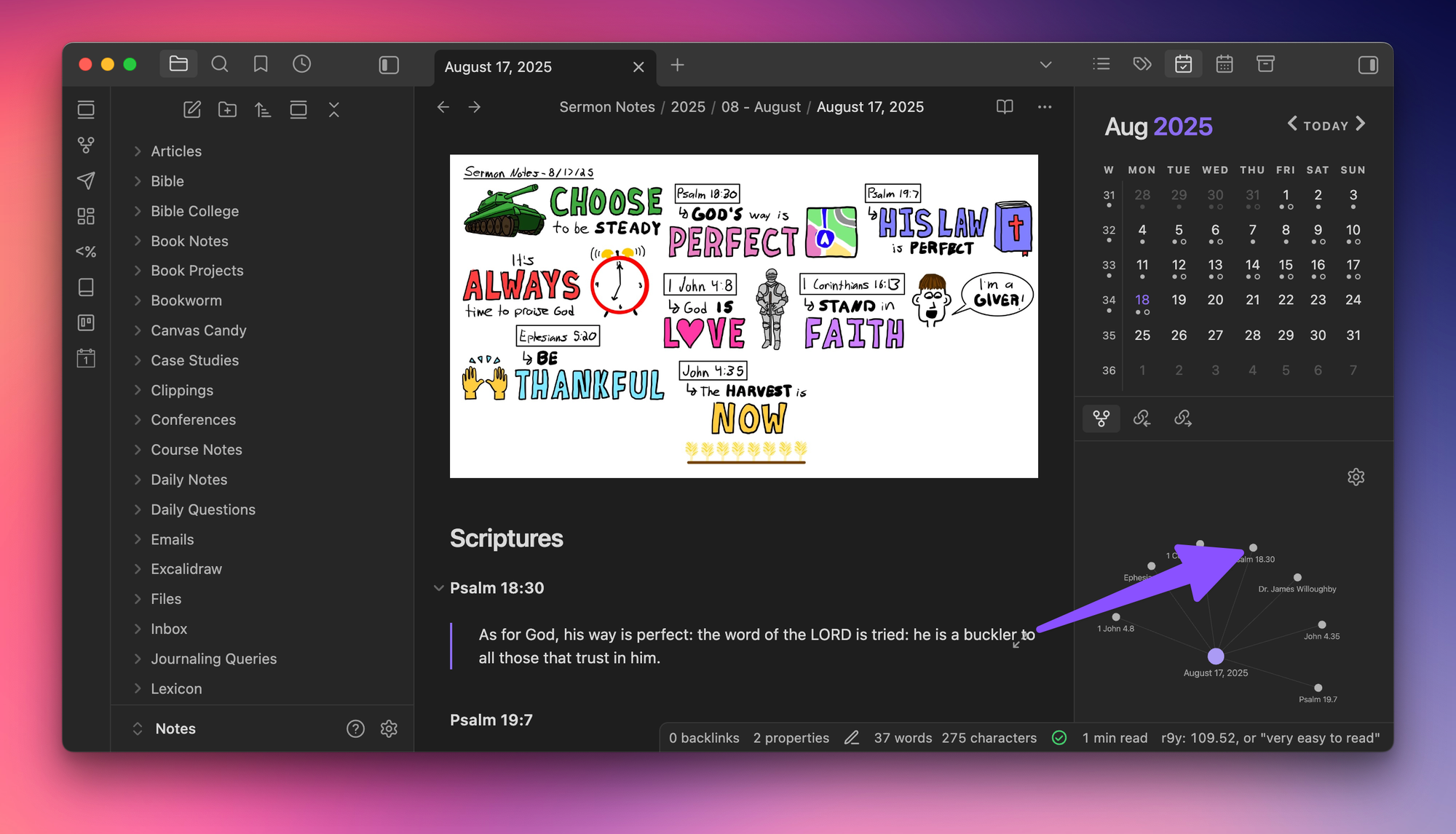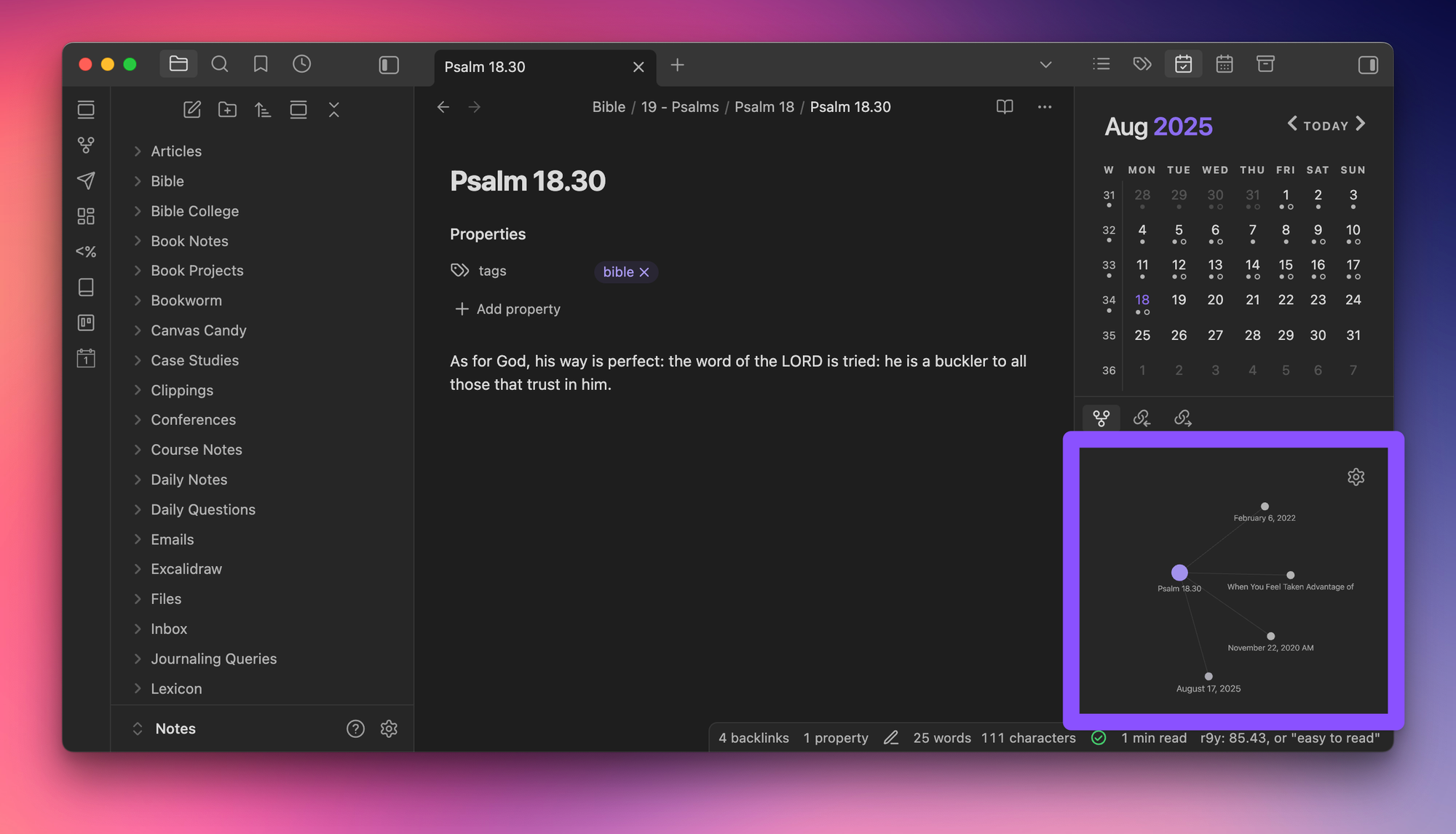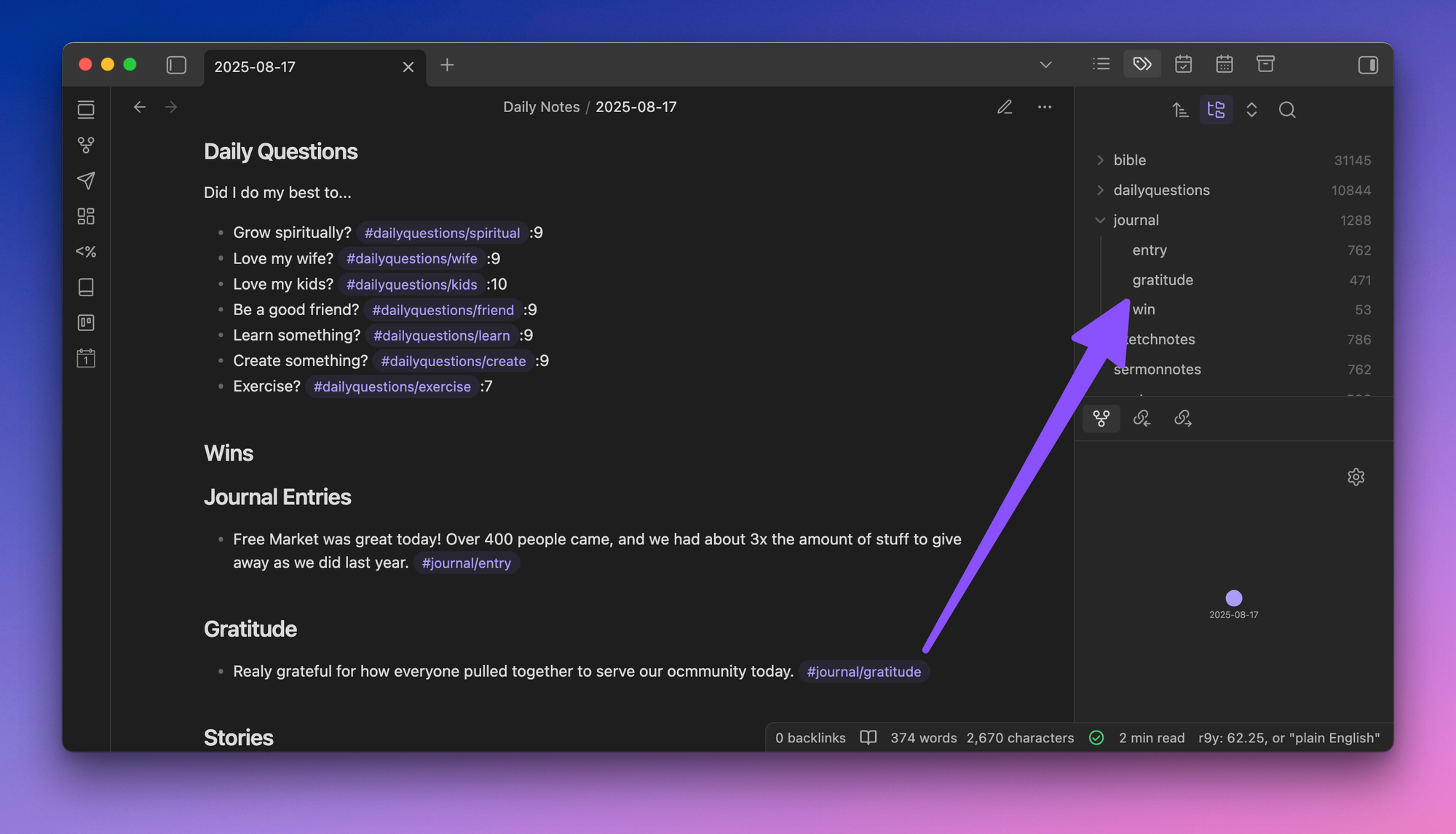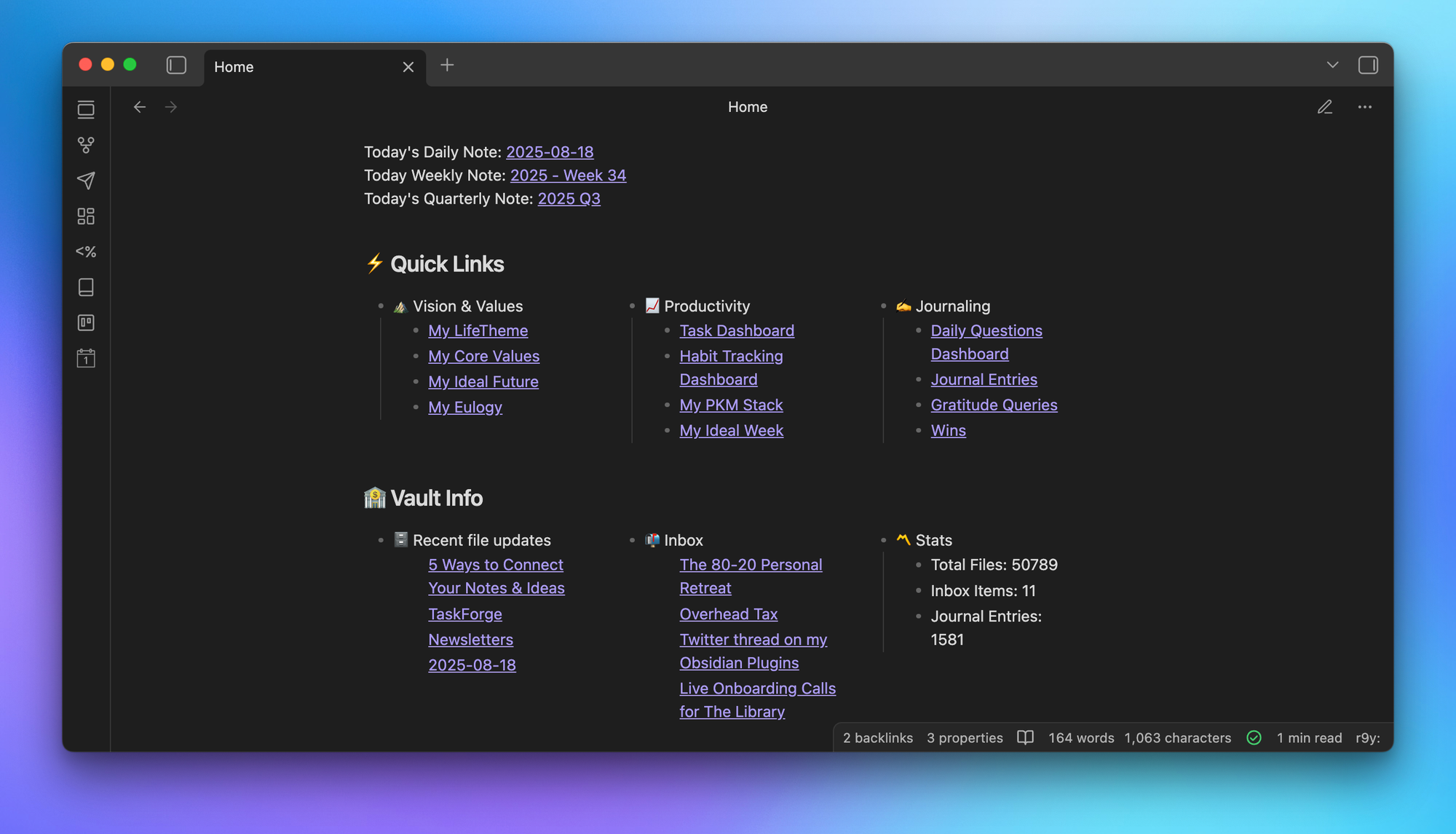The unfulfilled promise of PKM is that you’ll be able to get additional insight from your connected notes. But you can’t just dump things into a new connected notes app and have things magically unlock for you.
You can’t automate the sensemaking process (don't delegate this to AI).
But if you are intentional about when and how you make connections, the creativity and productivity benefits far outweigh the cost.
In this post, I’m going to share the five ways to connect things in your personal knowledge management (or PKM) system and show you how to use them to get more insight and inspiration out of the notes & ideas you already have.

Note Links
The first way you can connect things is via Note Links. These bidirectional links allow you to create explicit links between your notes by putting a note title in between double brackets, like so:
[[Note 1]]
Note Links are the thing that got me into PKM in the first place.
These links allow you to navigate from one note to another, but what’s unique about a linked notes app like Obsidian is that each link is actually a two-way street.
For example, if you had a standard wiki-style link in Note 1 to Note 2, you could click the link to go from Note 1 to Note 2. But you couldn’t go back unless you had another link from Note 2 back to Note 1.
This is possible in an app like Obsidian, though, because that one link creates a connection that you can follow from either direction.
Because the graph view in Obidian shows both outgoing links (links from the active note) AND backlinks (links to the active note), it’s easy for even the Local Graph to get a little unwieldy.
Which is why I recommend that you make these direct note links sparingly and intentionally.
You want each link to really mean something. And you definitely don’t want to automate these links using something like AI.
One of the ways I use note links is for my sermon sketchnotes, where I link to each individual verse that is mentioned.

Then I can open a note, click a verse that I linked to open it, and see all the other notes I’ve taken that also link to that verse.

The result? My own cross-reference library that I can use as a source of inspiration whenever I need to put together a message of my own.
Tags
The second way you can link things together is by using tags.
Tags have been around for a long time. Many apps offer tagging as a way to group things together by topic, and if you understand how tags work anywhere else, you’ll instantly be able to use them in Obsidian as well.
There are two types of tags in Obsidian:
- Inline tags that appear in a line of text by using the
#character (i.e.#quote) - Note-level tags that appear in the metadata for the note itself via the tags Property
I use inline tags for my Daily Questions journaling workflow and for things like quotes I want to remember from books that I read.
But note-level tags are a great way to group related notes together by topic.
For example, I use note-level tags for the different types of articles I write, for denoting which files contain notes from books that I’ve read, and for organizing my conference notes.
One of the things that isn’t obvious about tags in Obsidian is that you can actually have nested tags (or subtags). For example, all of my journal entries get the inline #journal tag. But I use different subtags for each type of journal entry I capture (entry, gratitude, and win). So when I capture my daily gratitude during my evening journaling routine, I add the #journal/gratitude tag. This actually applies both tags, but makes it easy to organize them in the Tags pane in the right sidebar (assuming you have the Tags View core plugin enabled):

Here are a couple of best practices when it comes to tagging:
- Tag consistently — If you’re going to use a tag for something, make sure that you use it the same way every time.
- Tag sparingly — Not every note needs a tag, but every note that has a tag needs to mean something.
- Tag memorably — Your tags don’t need to make sense to anyone else but you. The more memorable they are, the more likely you are to use them.
Folders
The third way you can connect things is by using Folders.
The best part about using folders is that you probably already have lots of practice with this. The files on your computer are organized in folders, as are the messages in your email inbox.
Folders are an easy way to group things together by dragging them into the same location. I like to use folders to group things by type.
For example, all of my book notes are kept together in a single folder. I also group all my creative writing projects in related folders (i.e., Articles, Newsletters, Video Scripts, etc.)
Unlike tags, you cannot have a file be in more than one physical location on your drive, which means that folders should be used as a first-level filter for organizing your notes and ideas.
Maps
Maps are simply opinion notes that you create that pull together related notes & ideas using a combination of Note Links & Tags.
I like the term Map better than Map of Content (or MOC) because most of the Maps in my Obsidian vault are more than just an index of linked pages. One of my favorite mental models is The Map is Not the Territory, which states that the map is simply a representation of the territory that reflects the opinions of the map maker.
When it comes to PKM, I believe you should embrace the role of the cartographer and make your own mental maps. So when I need to wrap my head around something, I’ll create a new opinion note (or Map) and start writing what I think about the topic. I like to use callouts to highlight important points, and I'll add links to related notes where appropriate as a way of synthesizing what I think.
Here's an example map I created on the topic of habits:

There’s a saying that goes, “thoughts disentangle themselves through lips and pencil tips.”
And I would add: also clicky keyboards.
Home Note
A Home Note is simply a jumping-off point inside your PKM system.
One of the cool things I’ve been able to do with my own Home Note is to use some inline DataviewJS code to display things like the notes that have been recently updated, the most recent ideas I’ve captured to my idea inbox, and stats about my vault like how many total notes there are and how many journal entries I’ve captured.
I also have a section of Quick Links that I can use to jump to my LifeTheme, my Core Values, my PKM Stack Canvas file, and my productivity and journaling dashboards. I even have some custom DataviewJS snippets that allow me to jump to the active daily, weekly, and quarterly notes:

(BTW, if you want a prebuilt version of this, it’s included LifeHQ.)
Out of all of the methods for connecting things, this one is the least critical in my opinion. It’s nice to have, but the payoff isn’t huge, and it does tend to take a while to set this all up. Having a note like this that can point you in specific directions isn’t absolutely necessary for you to start getting insight out of connecting your notes and ideas.
So if you're going to start small, I recommend you take a look at how you're currently using links, tags, and folders first. Then, over time, you can create your own maps and eventually your own custom Home note.
The key is to let your organizational structure develop organically. You can use premade systems as a starting point, but you need to make it your own by following your brain's path of least resistance. I wrote about this further in this post on "desire paths" and their role in PKM.
But for now, just know that when it comes to organization, whatever feels right is probably right.





